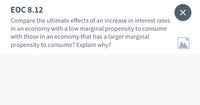
ENGR.ECONOMIC ANALYSIS
14th Edition
ISBN: 9780190931919
Author: NEWNAN
Publisher: Oxford University Press
expand_more
expand_more
format_list_bulleted
Question
Compare the ultimate effects of an increase in interest rates in an economy with a low marginal propensity to consume with those in an economy that has a larger marginal propensity to consume? Explain

Transcribed Image Text:ЕОC 8.12
Compare the ultimate effects of an increase in interest rates
in an economy with a low marginal propensity to consume
with those in an economy that has a larger marginal
propensity to consume? Explain why?
Expert Solution
This question has been solved!
Explore an expertly crafted, step-by-step solution for a thorough understanding of key concepts.
This is a popular solution
Trending nowThis is a popular solution!
Step by stepSolved in 2 steps

Knowledge Booster
Learn more about
Need a deep-dive on the concept behind this application? Look no further. Learn more about this topic, economics and related others by exploring similar questions and additional content below.Similar questions
- True or false: The slope of the consumption function is the marginal propensity to consume (MPC). Assume the marginal propensity to consume (MPC) is .8. Suppose real disposable income increases by $1000. Solve for the change in consumption. Assume again that the marginal propensity to consume (MPC) is .8. What must be the marginal propensity to save (MPS)? Assume that the marginal propensity to consume (MPC) is .9. Solve for the value of the "simple spending multiplier." Using the value of MPC and the value of the "simple spending multiplier" in question 10, introduce an increase in investment of $1000. Solve for the change in real GDP that results.arrow_forwardThe value of marginal propensity to consume is 0.44 Calculate the value of Marginal propensity to save?arrow_forwardConsider a hypothetical economy where there are no taxes and no foreign trade, and households spend $0.90 of each additional dollar they earn and ; the marginal propensity to save (MPS) for this save the remaining $0.10. The marginal propensity to consume (MPC) for this economy is economy is ; and the multiplier for this economy is Suppose investment spending in this economy decreases by $150 billion. The decrease in investment will lead to a decrease in income, generating a decrease in consumption that decreases income yet again, and so on. Fill in the following table to show the impact of the change in investment spending on the first two rounds of consumption spending and, eventually, on total output and income. Hint: Be sure to enter a negative sign in front of the number if there is a decrease in consumption. Change in Investment Spending = -$150 billion First Change in Consumption = $ Second Change in Consumption $ Total Change in Output = $ billion billion billion In reality,…arrow_forward
- Explain why the marginal propensity to save and the marginal propensity to consume sum to 1.arrow_forwardShow that if the multiplier is one, the slope of the savings schedule is one.arrow_forwardAssume taxes are zero and an economy has a consumption function of C = 0.64 (Yd) + $250.19. What is the marginal propensity to save for this economy? Round your answer to two digits after the decimal.arrow_forward
- Illustrate how changes in investment (or other components of total spending) can increase or decrease real GDP by the multiplier effect.arrow_forwardIf the marginal propensity to save (MPS) is 0.70 and autonomous consumer spending is 100, what is the aggregate consumption function? C= 0.80*Y + 100 C= 0.80*Y + 80 C= 0.20*Y + 80 C= 0.30*Y + 100arrow_forwardHow does the marginal propensity to consume (MPC) determine how GDP responds to policy changes? If we want MPC to be high, what implications does this have for how we should design policies?arrow_forward
arrow_back_ios
SEE MORE QUESTIONS
arrow_forward_ios
Recommended textbooks for you

 Principles of Economics (12th Edition)EconomicsISBN:9780134078779Author:Karl E. Case, Ray C. Fair, Sharon E. OsterPublisher:PEARSON
Principles of Economics (12th Edition)EconomicsISBN:9780134078779Author:Karl E. Case, Ray C. Fair, Sharon E. OsterPublisher:PEARSON Engineering Economy (17th Edition)EconomicsISBN:9780134870069Author:William G. Sullivan, Elin M. Wicks, C. Patrick KoellingPublisher:PEARSON
Engineering Economy (17th Edition)EconomicsISBN:9780134870069Author:William G. Sullivan, Elin M. Wicks, C. Patrick KoellingPublisher:PEARSON Principles of Economics (MindTap Course List)EconomicsISBN:9781305585126Author:N. Gregory MankiwPublisher:Cengage Learning
Principles of Economics (MindTap Course List)EconomicsISBN:9781305585126Author:N. Gregory MankiwPublisher:Cengage Learning Managerial Economics: A Problem Solving ApproachEconomicsISBN:9781337106665Author:Luke M. Froeb, Brian T. McCann, Michael R. Ward, Mike ShorPublisher:Cengage Learning
Managerial Economics: A Problem Solving ApproachEconomicsISBN:9781337106665Author:Luke M. Froeb, Brian T. McCann, Michael R. Ward, Mike ShorPublisher:Cengage Learning Managerial Economics & Business Strategy (Mcgraw-...EconomicsISBN:9781259290619Author:Michael Baye, Jeff PrincePublisher:McGraw-Hill Education
Managerial Economics & Business Strategy (Mcgraw-...EconomicsISBN:9781259290619Author:Michael Baye, Jeff PrincePublisher:McGraw-Hill Education


Principles of Economics (12th Edition)
Economics
ISBN:9780134078779
Author:Karl E. Case, Ray C. Fair, Sharon E. Oster
Publisher:PEARSON

Engineering Economy (17th Edition)
Economics
ISBN:9780134870069
Author:William G. Sullivan, Elin M. Wicks, C. Patrick Koelling
Publisher:PEARSON

Principles of Economics (MindTap Course List)
Economics
ISBN:9781305585126
Author:N. Gregory Mankiw
Publisher:Cengage Learning

Managerial Economics: A Problem Solving Approach
Economics
ISBN:9781337106665
Author:Luke M. Froeb, Brian T. McCann, Michael R. Ward, Mike Shor
Publisher:Cengage Learning

Managerial Economics & Business Strategy (Mcgraw-...
Economics
ISBN:9781259290619
Author:Michael Baye, Jeff Prince
Publisher:McGraw-Hill Education